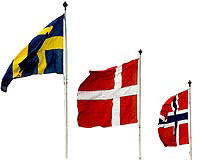Scandinavian folklore is real amazing
 Scandinavian folklore is the folklore of Sweden, Norway, Denmark, Iceland, the Faroe Islands, and the Swedish speaking parts of Finland.
Scandinavian folklore is the folklore of Sweden, Norway, Denmark, Iceland, the Faroe Islands, and the Swedish speaking parts of Finland. In Scandinavia the term 'folklore' is not often used in academic circles, instead terms such as Folketro (folk belief (older Almuetro)) or Folkesagn (folk tales) have been coined. In common speech, it is simply referred to as den Gamle Tro (the old belief), or perhaps sæd skik og brug (customs, the way). It evolved from Norse paganism, and it is in technical terms labelled low-mythology, while the norse mythology is called high-mythology. High-mythology builds on low-mythology in its parts. The Christianization of Scandinavia around the 10th century meant that the high-mythology more or less phased out of use. This process may have been quite rapid because these never were the beliefs of the lower classes. Iceland and the Faroe Islands are not a part of Scandinavia (although they are Nordic countries), but should nevertheless be regarded as Scandinavian in folkloric terms. The folklore/religion of Finland and of the Sami people are clearly related to Scandinavian folklore/religion, but have retained an independent character.
In Scandinavian folklore, belief in the old gods still exists, but not in the form they show in high mythology. Some of the ones known in both forms of mythology are Odin (Oden), who is said to lead the Wild Hunt; Thor (Tor) who still chases trolls with his thunder, both in this context regarded as "jægere" (hunters), and we see also Ull (as Ul) and Hœnir in this role. Loki, as a housegod of the housefire, and sometimes Freyja, show up. A large number of different mythological creatures from Norse mythology continue to live on, surprisingly little affected by Christian beliefs, even though the wicked ones at times find an ally in the Devil or had problems with Christian symbols. Nothing was surer, though, to scare these beings than a piece of steel, such as a strategically placed pair of scissors or a knife, or with salt and fire. The stories about the livings and doings of these beings, and their interaction with humans, constitute the major part of Scandinavian folklore. Even the helpful tomte, nisse, gårdbo or gårdbuk could turn into a fearsome adversary if not treated with caution and respect. Many of them blend into each other when their morals and/or place of residence are similar, and equally when one moves from one region in Scandinavia to another

Comments